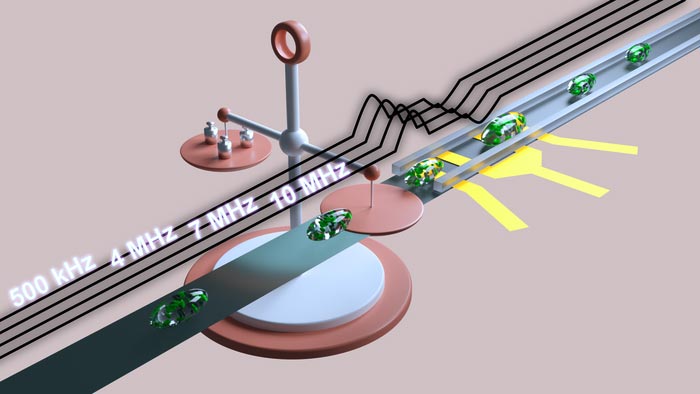A rapid and precise total assessment method for cells

Precise total assessment of the cells with impedance signals.
Credit: Tao Tang, Yaxiaer Yalikun
From outside to inside:
Researchers at Nara Institute of Science and Technology show that using four frequencies of applied voltage can improve the measurement of cell size and shape during impedance cytometry, enabling to enhance the speed and accuracy of biological experiments.
Having a good eye for detail is an essential skill for many professions. In particular, biologists use special techniques and advanced technology to analyze individual cells with unprecedented precision. Impedance cytometry is one experimental method that can reveal specific characteristics of living single cells. This technique requires electrical penetration, in which high-frequency current can freely pass through the cell membrane, without damaging the cell. Now, researchers from Japan have determined optimal conditions to perform impedance cytometry. Their work may lead to rapid assessment of cells during culture in biological experiments.
An improved method for measuring the morphology and biomass of single cells using impedance cytometry has been introduced in a recently published study in Microsystems & Nanoengineering. Impedance cytometry involves applying high-frequency voltages to electrodes to measure complex impedance, which can provide information about the shape and effective volume of the cell. In the study, researchers led by Nara Institute of Science and Technology used different phases of voltage signals at four frequencies. They showed that applied voltages with frequencies of around 7 MHz are able to pass through the membrane of Euglena gracilis cells. Higher frequencies can monitor changes in biomass, while lower frequencies can track volume changes.
When a high-frequency electrical field penetrates the cell membrane, the uneven intracellular distribution tilts the impedance pulses to the left or right, which has been verified in simulation and experiments. “Ultimately, our method for determining the conductivity of the cell membrane relies on the degree of tilt caused by the electrical pulses,” says author Yoichiroh Hosokawa. The team also performed calibration studies using beads to better understand the underlying physical mechanisms of this effect.
“This research enables the easy determination of the electrical penetration of a cell membrane, and the proposed platform is applicable to multiparameter assessment of the organism’s state during cultivation,” says senior author Yaxiaer Yalikun. This platform may be easily integrated into microfluidic systems for the scalable monitoring of biological experiments.
The need for efficient and highly accurate analysis of living single cells may be met by this new impedance cytometry method developed by the research team led by Nara Institute of Science and Technology. Future applications could be extended to cells in mammals to monitor specific membrane changes in fields such as oncogenesis and cell aging.
Resource
Title: Assessment of the electrical penetration of cell membranes using four-frequency impedance cytometry
Authors: Tao Tang, Xun Liu, Yapeng Yuan, Tianlong Zhang, Ryota Kiya, Yang Yang, Kengo Suzuki, Yo Tanaka, Ming Li, Yoichiroh Hosokawa & Yaxiaer Yalikun
Journal: Microsystems & Nanoengineering
Information about the Bio-Process Engineering Laboratory can be found at the following website: https://mswebs.naist.jp/english/courses/list/labo_11.html
Journal: Microsystems & Nanoengineering
DOI: 10.1038/s41378-022-00405-y
Article Title: Assessment of the electrical penetration of cell membranes using four-frequency impedance cytometry
Media Contact
Takahito Shikano
Nara Institute of Science and Technology
press_contact@rsc.naist.jp
All latest news from the category: Life Sciences and Chemistry
Articles and reports from the Life Sciences and chemistry area deal with applied and basic research into modern biology, chemistry and human medicine.
Valuable information can be found on a range of life sciences fields including bacteriology, biochemistry, bionics, bioinformatics, biophysics, biotechnology, genetics, geobotany, human biology, marine biology, microbiology, molecular biology, cellular biology, zoology, bioinorganic chemistry, microchemistry and environmental chemistry.
Newest articles

Retinoblastoma: Eye-Catching Investigation into Retinal Tumor Cells
A research team from the Medical Faculty of the University of Duisburg-Essen and the University Hospital Essen has developed a new cell culture model that can be used to better…

A Job Well Done: How Hiroshima’s Groundwater Strategy Helped Manage Floods
Groundwater and multilevel cooperation in recovery efforts mitigated water crisis after flooding. Converting Disasters into Opportunities Society is often vulnerable to disasters, but how humans manage during and after can…

Shaping the Future: DNA Nanorobots That Can Modify Synthetic Cells
Scientists at the University of Stuttgart have succeeded in controlling the structure and function of biological membranes with the help of “DNA origami”. The system they developed may facilitate the…



